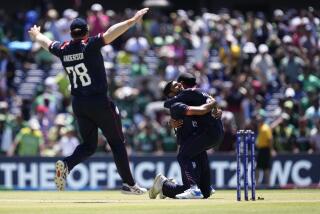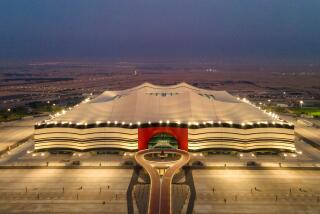Venues Shaping Up as Sticky Wicket in Cricket Cup
- Share via
NEW DELHI — Invisible but undeniable threads link Hemant, an urchin in worn trousers playing in a rainy side street of the Indian capital, with long-dead English lords.
The 8-year-old schoolboy is armed with a chopped-down wooden plank and faces a playmate hefting an old tennis ball. Behind Hemant is a stone slab he must guard with his bat.
The shouts are in Hindi, the two-hour game tailored to the rough contours of life in the bustling Lodhi Colony neighborhood. But to a youngster from the Australian Outback, an earl in Victorian England or a poor boy living in a Jamaican slum, the essence is obvious: This is cricket, that other sport played with a bat and ball.
Through a superb irony of fate, the game long associated with genteel English summers has been embraced with single-minded passion in some of the world’s poorest lands. And for the next month, productivity in workplaces from Sri Lanka to the West Indies will plummet, pupils by the hundreds of thousands will play hooky and millions of television viewers will grow glassy-eyed during cricket’s quadrennial jamboree, the World Cup.
A dozen national teams will do battle on grassy ovals in India, Pakistan and Sri Lanka for the 1996 championship. Play opens today in the western Indian textile town of Ahmedabad, with England facing New Zealand, and climaxes March 17 with the final in Lahore, Pakistan.
Tens of millions of cricket fans and cognoscenti, and an international television audience estimated to top 2 billion, are looking forward to the upcoming 37 games the way an American football junkie would a month full of Super Bowls.
“Modern cricket is like a musical concert playing the mind-blowing compositions of Beethoven and Mozart,” Sadanand Vishwanath, who used to be on the Indian national team, said lyrically.
“Don’t plan on getting anything done in India this month,” a more matter-of-fact Indian has warned a U.S. diplomat. At the British High Commission in New Delhi, an employee said, ‘We’ll be coming to work, but the radios will be on, and not a lot may get done.’ ”
For Americans, to be sure, cricket’s lure may be as impenetrable as its jargon (one type of bowled ball is a “googly,” one defensive position a “silly mid-on”) and pace (matches are interrupted for luncheon and drinks, and so-called international “tests” can last for five whole days and not produce a winner).
The fact is, however, that the first international cricket game ever played actually pitted the United States against Canada in 1844. And the Americans won. Had baseball not come along a few years later, one of the U.S. networks might be carrying wall-to-wall coverage of an 11-member Team USA this month.
Unfortunately, not all the action coming up may be on the grass. This year’s hosts are a country torn by civil war (Sri Lanka), another where the largest city is in criminal free fall (Pakistan) and India, where almost anything can happen.
To disrupt play, “all you need is one madman,” said Mansur Ali Khan, a former Indian captain who will be refereeing at least four games. “And there are plenty of those in this part of the world.”
As a matter of fact, there already has been enough controversy surrounding the event to cause a diplomatic incident. Last month, a terrorist truck bombing in the Sri Lankan capital, Colombo, killed more than 80 people and convinced the Australians, the odds-on favorites, and then the West Indians to forfeit their scheduled games there.
Sri Lanka reacted as if an Australian warship had sailed into Colombo harbor with guns blazing. It warned Australia that if it tried to organize a boycott by the other countries scheduled to play on the island--Zimbabwe and Kenya as well as the West Indies--it would be treated as a “hostile act.”
The media howled that the Australians, who already had accused a Sri Lankan player of illegally bending his arm while bowling, were simply afraid to lose. And the tournament organizers, the Pakistan-India-Lankan Committee, called on the United Nations to help settle the issue. (The U.N. didn’t respond.)
Then there’s cricket-crazy Pakistan, which won the cup the last time around, in 1992, in Melbourne, Australia. In strife-torn Karachi, where more than 40 people have been murdered this month, an armed dissident group has threatened through its newspaper to disrupt play if the government does not end alleged “harassment” of its activists.
Plainly worried about what could happen, the government of Prime Minister Benazir Bhutto has beefed up security for the 16 games to be played in Pakistan. But during a recent practice in the city of Lahore, 10,000 spectators swarmed onto the field, apparently shocked at the Pakistani players’ decision to break for drinks during the fasting month of Ramadan. The game had to be abandoned.
Finally, in India, Hindu extremist leader Bal Thackeray announced last year that he and his toughs would not allow the Pakistani squad to play in India--which could happen if India’s unfriendly neighbor makes the quarterfinals and semifinals.
Although this year’s tournament includes teams from the Netherlands and the United Arab Emirates, cricket, like gin and tonic, was an export of the British Empire.
In Australia, prowess with the willow bat and leather-hided ball became an enormous source of national pride. “It was something we could beat the English at. It helped build our self-esteem,” said Chris Uhlmann, an Australian who lives in India.
In India, where the game was originally the province of British settlers and the army, cricket was a socially useful way of aping one’s rulers.
“Sport was one of the ways the British accepted you,” said Khan, the former Indian captain. “I remember going to school in England when I was 11. One of the reasons I was accepted was that I was good at games, not because I was good at Latin. Not to say I was good at Latin.”
From maharajahs and the urbane members of the Parsee religious sect, the game spread to India’s Hindu and Muslim populations. As a spectator sport, its popularity skyrocketed after independence when All-India Radio and Doordarshan television began providing commentary in Hindi as well as English. In a moment of pride shared by Indians regardless of language, caste, class or religion, India won the World Cup in 1983.
Pakistan’s triumph in Melbourne four years ago was due in large part to the leadership of captain Imran Khan. The strikingly handsome, aristocratically mannered Khan, 42, now makes headlines at home by denouncing Pakistan’s “brown sahibs,” or imitators of the West, and widespread official corruption. In one of the international jet set’s smartest events, he wed Jemima Goldsmith, the daughter of an Anglo-French tycoon.
Pakistan’s government is worried enough about his political potential to have deleted the now-retired Khan from video snippets of the 1992 tournament shown on state television.
An Englishman once said of cricket: “It’s more than a game. It’s an institution.” These days it’s also a mega-business. At the World Cup, Fuji is the official film, Visa the official credit card. A U.S.-based company, WorldTel, has forked over $10 million for the TV rights, and there’s more than $350,000 in prize money.
Eight-year-old Hemant and his playmates know no more of this than they do of cricket’s English origins. For them, the game they play two hours a day and all day Sunday is as Indian as mustard greens and corn bread.
“We’re sure India will win the World Cup,” they proclaim, although they are not even sure which country the tournament is taking place in.
(BEGIN TEXT OF INFOBOX / INFOGRAPHIC)
BACKGROUND
Formal rules for cricket were established in 1744 in England. Like baseball, the object is to hit the ball and score runs. But cricket scores run into the hundreds. There are no balls, fouls or strikes, and players keep hitting until they’re out. The game is played on a large field called an oval. In the middle is a 66-by-10-foot dirt “wicket.” At each end of the wicket is something else also called a wicket: three narrow sticks stuck into the ground, across which two small pieces of wood rest. The pitcher runs up from behind one batter and throws the ball so that it bounces at the far batsman’s feet. The batsman swings his paddle-shaped bat with two objectives: to protect the wicket behind him and to score runs.
More to Read
Go beyond the scoreboard
Get the latest on L.A.'s teams in the daily Sports Report newsletter.
You may occasionally receive promotional content from the Los Angeles Times.










